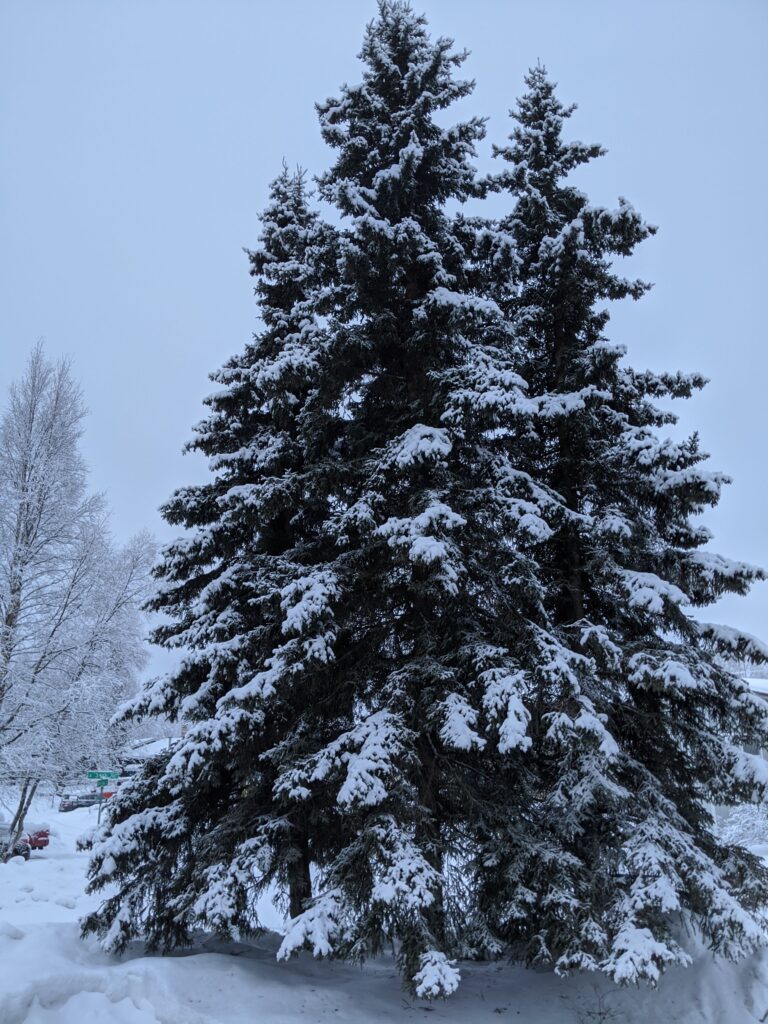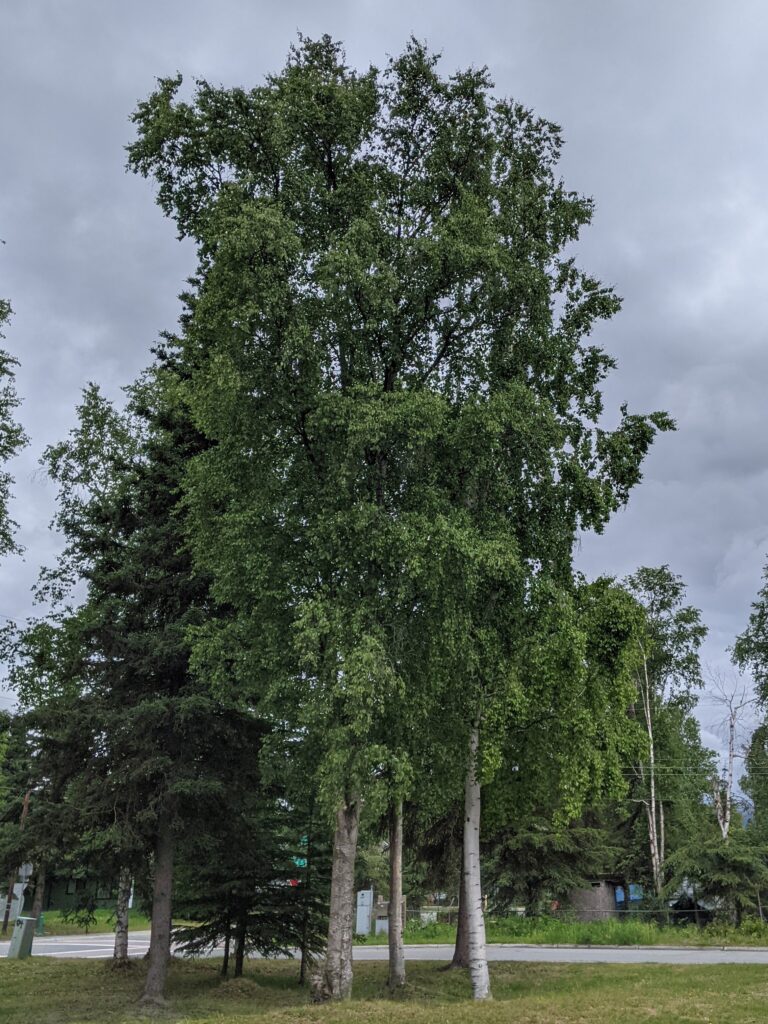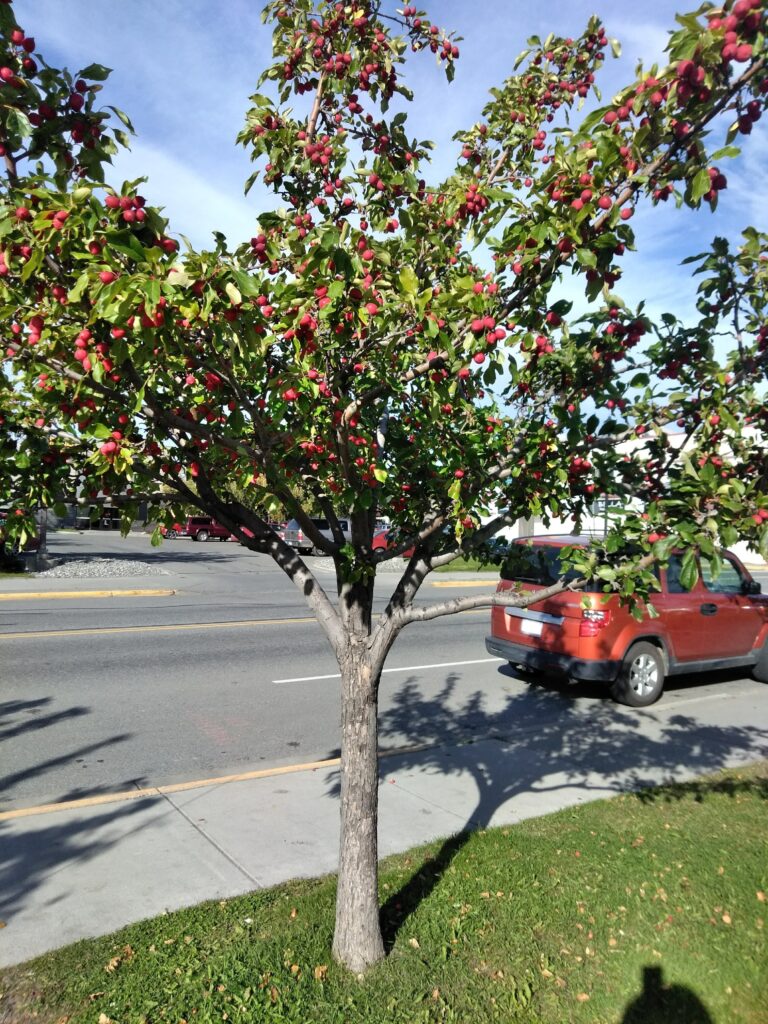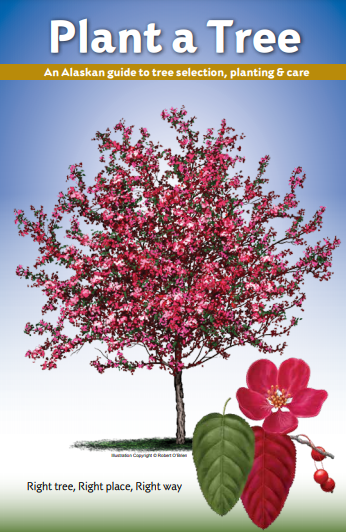Choosing a replacement tree
After losing a spruce to spruce beetle, many landowners have questions about replanting. Deciding what to replant depends on your privacy needs, aesthetic preferences, and the level of maintenance you are willing to contribute. Below are the pros and cons of a few of our local tree species, as well as helpful tips on how to plant and care for your new tree.
Conifers – Spruce, Larch
Replanting a spruce where a spruce had successfully grown is a safe bet for selecting a tree suitable for your site. White spruce, Sitka spruce, and black spruce are native to Alaska and are well-adapted to withstand our long, cold winters. Spruce are evergreen, so they retain their aesthetic appeal and privacy year-round. A young spruce planted now will not be susceptible to spruce beetle for several decades, so don’t be afraid to replace a beetle-killed spruce with another spruce tree. Another commonly planted ornamental conifer in Alaska is Siberian larch. Siberian larch is a large, attractive conifer however be aware that it will drop its needles every fall so it will not provide as extensive of privacy during the winter months as a spruce would.
Photo of white spruce in winter, A. Wenninger UAF Cooperative Extension Service.

Hardwoods – Birch, Aspen, Cottonwood
Alaska is home to three predominant species of hardwood trees that do well in yards and gardens: Alaska paper birch, trembling aspen, and black cottonwood. Hardwood species can be appealing due to their fast growth and dense summer foliage which provides overhead shade and privacy from neighbors. However, hardwoods lose their leaves in the fall, which reduces privacy and shade through the winter season. Another consideration is that they can require some maintenance in the form of raking or mulching leaves. Aspen and cottonwood reproduce by sending up new sprouts from the roots called suckers; this may be beneficial if you are looking to fill a larger area with trees over time. For cottonwood specifically, sticky buds will fall from the tree in spring so you may wish to avoid placing cottonwood over vehicle parking areas.
Photo of mature birch trees, A. Wenninger UAF Cooperative Extension Service.

Fruit-bearing Trees – Crabapple, Apple, Cherry
Folks looking for more utility out of their landscaping might consider planting a tree that bears edible fruit. Fruit trees produce fragrant blossoms in spring and an edible harvest in fall which can be used to make various preserves including jams, sauces, or ciders. There are several varities of cold-hardy crabapples, apples, and cherries which do well in Alaska, and their long history of selective breeding has created many options which can be carefully selected to match the size and conditions of the intended landscape. Keep in mind that fruit trees do require more maintenance than other landscape trees as the fruit can become messy or attract unwanted wildlife if it is not harvested. Also be aware that some fruit tree varieties may require the planting of a pollinizer – a second tree which provides cross-pollination for fruit set.
UAF Cooperative Extension Service offers free publications on this topic. For help selecting varieties of edible fruit trees check out “Growing Fruit Trees in Alaska”. For recipes for using crabapples see the publication titled “Crabapples”. To download a digital copy of these publications visit the UAF CES Publications Catalog.
Photo of an edible crabapple tree, A. Wenninger UAF Cooperative Extension Service.

Choosing the best location for your tree
The first step in planting a tree is to carefully consider placement. Place the tree in an area where you would like shade or privacy, but avoid planting the tree where it could become a problem. Open areas with adequate drainage are ideal for fast-growing trees. Some areas to avoid are near sidewalks, homes, or utility lines. Trees near sidewalks may obscure traffic signs, damage sidewalks, and have difficulty spreading roots. Trees near homes will shed leaves or needles onto rooftops and pose a hazard if the tree becomes damaged. Trees beneath overhead power lines or on top of underground utility lines can disrupt services and create a hazard. Always consult with utility professionals before digging to avoid damaging underground lines – contact Alaska 811 for information about utilities on your property before beginning a project.
Sourcing Seedlings
There are two main options for sourcing tree seedlings; the first option is to purchase a seedling from a local nursery or plant sale in your area, the second option is to transplant a seedling. Transplanting seedlings can be a cost-effective way to replace trees but may require some additional preparation. Before transplanting seedlings from public or private property be sure to contact the landowner for permission. To harvest seedlings from state land contact the Department of Natural Resources Public Information Center. Seedlings that make good candidates for transplant are those that are small in diameter, have one main stem, and are free of signs of wounds or disease. It is important to keep as much of the root system intact when digging up the seedling – remember that the root system is often wide and shallow, so begin digging at least as far from the trunk as the outermost branch tips. You may wish to wrap the roots in plastic to prevent drying during transportation. For more detailed information about all aspects of transplanting trees and seedlings in Alaska check out the pdf publication titled “Transplanting Trees” provided by the Alaska Division of Forestry & Fire Protection – Community Forestry Program.
Planting and caring for your tree
Dig a wide, shallow hole that is wider than the root ball of the tree you are planting. Place the tree so that the trunk flare is above the soil surface — do not pile extra soil up around the trunk of the tree or bury the tree deeper than the trunk flare. Once the tree is placed at the correct depth, fill soil back in around the sides in increments, watering in between to help settle the soil. Adding mulch around the base of the tree, spaced 3 inches away from the trunk, can help retain soil moisture, prevent root compaction from traffic too close to the tree, and prevent accidental damage to the trunk from lawn equipment. Newly transplanted trees should receive supplemental watering their first few years while their roots become established. Even established trees can benefit from supplemental watering during hot/dry summers.
Plant a tree: an Alaskan guide to tree selection, planting, & care
UAF Cooperative Extension Service and the Alaska Division of Forestry & Fire Protection – Community Forestry Program have a free tree care guide that covers choosing a location for your tree, planting your tree, mulching and pruning your tree, and general tree care topics. This pdf is free to download.

Mitigating wildfire risk
Wildfire plays a significant ecological role in Alaska’s wildlands, and as a result many Alaskans live in areas that at times may be threatened by wildfire. The selection and care of the landscape trees and other vegetation can impact how defensible the space around the home is from fire. The Alaska Firewise Coordinating Group has put together a manual to help homeowners take effective steps to protect their homes and properties. The Alaska Firewise Manual is free to download, and includes advice on landscape topics such as pruning trees, choosing vegetation, and spacing trees from homes.
